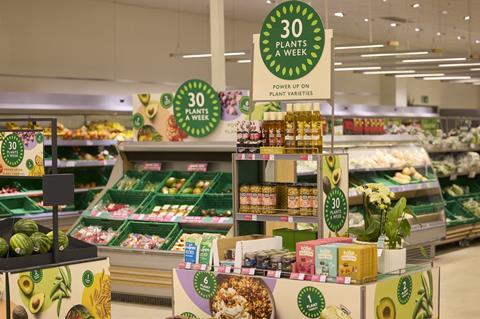
For years, the nation’s dietary advice has been anchored in the familiar 5-a-day message – a simple, effective way to encourage healthier habits by eating more fruit and vegetables. But as our understanding of nutrition evolves and the awareness of what’s in our food increases, so do the ways we measure a healthy diet.
While 5 a day was a good starting point, it didn’t always showcase the importance of variety and acknowledge the nutritional benefits of other nutritious food types like seeds, herbs, wholegrains and spices. It often led people to eat the same fruits or vegetables repeatedly throughout the week.
The 30 plant points model encourages a smarter and more adventurous approach to eating. One point comes from each unique plant – a definition that spans fruits and vegetables, wholegrains, legumes, nuts, seeds, herbs, and spices. By recommending the consumption of at least 30 of these foods each week, it offers a more comprehensive and meaningful way to track the variety of plants in our diets.
Diverse diets
This broader approach reflects growing evidence that dietary variety, particularly when it comes to plant-based foods, is hugely important. In 2018, the British and American Gut Project recommended eating more plants as a way to feed a wider range of gut bacteria, which improves gut health, immunity and nutrient absorption.
Brands are now beginning to embrace the science and this new approach. Just last week, Grubby announced the launch of a new range specifically designed to help consumers reach the 30-point target. At Gosh, we are now clearly displaying plant points on every pack of our falafels, bites and snack packs.
We believe this is just the start. It won’t be long before the messaging of 30 plant points makes its way into schools, workplaces and supermarkets, with some major retailers already leading the charge. Soon other brands will be following our lead in encouraging consumers to be more discerning and value variety, viewing healthy eating as an opportunity to be more adventurous with food and cooking at home.
The importance of fibre
But we also recognise a vital truth: 96% of adults are not meeting fibre recommendations [National Diet and Nutrition Survey June 2025]. And the idea of 30 plants can seem intimidating or simply out of reach to those who aren’t sure what they should be eating to increase their fibre intake.
So when the majority of lunches still revolve around the sandwich and crisps formula, it is crucial to make plant diversity visible, accessible and delicious.
Encouragingly, the momentum is there. Nearly half of UK consumers (49%) now say they trust plant-based foods more than they did three years ago [UK ProVeg Smart Protein Report 2024]. Consumer behaviours and retailer offerings are also showing a strong uptake in plant-based models, and more specifically whole food and alternatives that aren’t ultra-processed.
So while 5 a day is still holding its ground, the appetite for diversity and hitting 30 plants a week is strengthening, and brands that offer clarity on packaging and labels stand to lead this movement and shift consumer attitudes.
It’s clear that the 30 plant points message is more than just a trend. It’s a smarter and more inclusive way to think about food. As a sector, we need to move beyond outdated guidelines and look to foster a more diverse path to better health – all while ensuring accessibility is at the forefront of these efforts.
Caroline Hughes, marketing director at Gosh Foods



















No comments yet